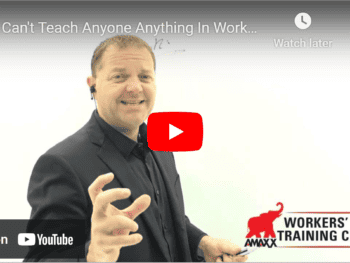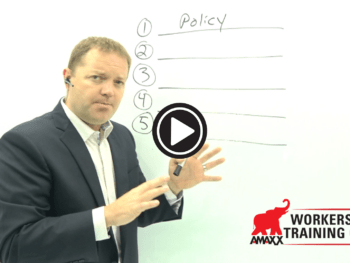The experience modification factor in workers’ compensation, it can be an overwhelming and complicated number. There’s a lot of math involved, and that can be overwhelming to look at and interpret what it means. But at its core, it’s a predictor of your future losses of how you’d handled workers’ compensation claims. Just like your credit score, as a predictor of how well you’re going to handle debt in the future, of how well you’ve handled it in the past. It’s no more complicated than that, as far as what it means. But it impacts your pricing significantly, as far as your premiums are concerned in workers’ compensation, particularly if you’re in a guaranteed cost program.
Click Link to Access Free PDF Download
Example – Calculating Minimum Experience Mod
Hello, my name is Michael Stack, and I’m the CEO of Amaxx. Today, I’m going to be walking you through a concept to calculate your lowest possible mod, or what’s also known as your minimum mod, and what that means as far as potential savings in your organization.
First thing let’s do, I want to take you to this example, and I want to show you how to calculate your minimum mod. It’s a very simple calculation. If you look here on the screen, what you’re going to see is an NCCI rating worksheet. There’s a whole bunch of numbers that are on the screen, but there’s only two that you need in order to calculate this minimum mod.
The first thing you’re going to do, is you’re going to look down here at this bottom part of the formula and you’re going to see the stabilizing value, and you’re also going to see your expected totals.
In order to calculate your minimum mod, or your lowest possible mod, also known as the mod that you would have, had you had zero injuries. The mod you would have if you have zero injuries and zero claim costs. So you would take that stabilizing value over your expected totals. Stabilizing value over your expected totals, and that’s how you calculate your lowest possible or minimum mod.
What To Do With Minimum Experience Mod
Now, the next thing then is to factor in what do you do with that? What does that actually mean as far as your organization is concerned? I want to take you to this example here on the board.
Here’s how your rating works in a guaranteed cost program. There’s a couple more elements, but I’m going to walk you through this, particularly if you’re in a high deductible or a loss sensitive plan as far as what that means for your total work comp costs, but this is a basic formula.
You take your payroll, in this case we use $10 million in payroll, times your class code rate. In this example, I just use 0.5 rate just to keep the numbers simple. This here is also known as your manual premium. So manual premium is your payroll times your rate. You may have a few different class codes, you may have different numbers of payroll in each class code, but ultimately it’s going to all factor in to what is ultimately your manual rate.
Then you take whatever adjustments are appropriate, in this case your experience mod. There’s also going to be some scheduled debits and credits at the discretion of your carrier, and that’s not in this formula here but that’s going to be in your ultimate total work comp payments formula. If you’re in a loss sensitive plan, those are going to factor in here as well. But just keeping this simple as far as this example, you take your manual premium times your experience mod and that’s your work comp premium in a guaranteed cost program.
In this example, your mod is 0.8. So if we go through some of the elements of an experience mod, 1.0 is considered average for the industry, whatever industry that you’re in. So the actuaries take, what are all the claim costs that happen for everyone in the trucking industry, what was the total cost, what was the average, and that’s a simplified version of how they come up with what is expected for that industry. All this is, is are you doing better or worse than average? Are you doing better or worse than average for your industry?
This one is 0.8, so you’re doing 0.2 below that 1.0, you’re doing better than average. Then it comes out to 400,000. So this is 500,000 times 0.8, and that gives you 400,000.
FREE DOWNLOAD: “5 Critical Metrics To Measure Workers’ Comp Success”
Reveal More Room to Improve Experience Modification Factor
The mistake that I see companies make a lot of times in this, is you say we’re at 0.8, we’re below 1.0, we’re doing really well. Good job for us. Hooray for us. Yay, we’re doing so great. We saved $100,000 from what we would be if we were at average for our industry. While that’s true, there’s a lot more to the story, and that’s where this minimum mod comes into play.
If you went through that stabilizing value over your expected totals, a lot of times, particularly the larger your organization is, the lower possible minimum mod you’ll have, and that has to do with the weighting value. We’re not going to get into that today. But the larger your organization, the lower lowest possible mod that you have.
Let’s say you do that calculation and your lowest possible mod is a 0.4. So you do the same calculation, the manual premium, which is 500,000, and you times that by 0.4, and you come up with 200,000 as you see here.
In essence, what this means is you’re paying twice as much as you could. You’re paying twice as much as you could if you had zero claim costs. What it does is it gives a very vivid example when you’re talking to your senior managers, when you’re talking to your clients as an insurance broker or any other service provider, to let them know how much room there still is to improve.
So when you’re patting yourself on the back here, and you’re throwing yourself a parade and a party for how well you’re doing, good job, just keep going. Keep implementing return to work programs, keep implementing injury response programs, keep implementing safety, wellness, injury prevention programs in order to continue to drive this number down, because there’s still a lot more room to grow. Don’t get lulled to sleep up here, because there’s a lot more improvements that can be made.
Obviously, there’s a lot more to talk about or we could talk about with the experience mod, but if you can understand this concept, understand how some of these numbers start to put together, it can put a lot more meaning behind what we’re doing in injury prevention and injury management.
Again, my name’s Michael Stack, I’m the CEO of Amaxx. Remember, your work today in workers’ compensation can have a dramatic impact on your company’s bottom line, just as we showed here, but it will have a dramatic impact on someone’s life, so be great.

Contact: mstack@reduceyourworkerscomp.com.
Workers’ Comp Roundup Blog: https://blog.reduceyourworkerscomp.com/
©2019 Amaxx LLC. All rights reserved under International Copyright Law.
Do not use this information without independent verification. All state laws vary. You should consult with your insurance broker, attorney, or qualified professional.
FREE DOWNLOAD: “5 Critical Metrics To Measure Workers’ Comp Success”








